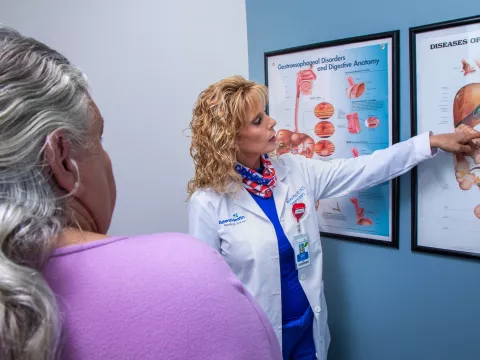- AdventHealth

Getting to the doctor for that annual mammogram is a huge step towards owning your health journey. But getting a phone call after regards findings from your test results? That can be scary. Does it mean you have breast cancer?
A questionable mammogram doesn't automatically mean cancer. In fact, according to the American College of Radiology, about 10 percent (100 out of every 1000) of women are called back for more tests. Of these, maybe 20 women will be recommended for a biopsy and four will be found to have breast cancer. That's four women out of every 1,000 mammograms.
If you're called back, our team understands you may be experiencing anxiety and well do everything we can to answer your questions and make you feel as comfortable as possible. Read below to learn what happens after you have a mammogram and what it means when you're asked to return for more tests.
Your Screening Mammogram
Screening mammograms are read within a few days. First, the report is sent to the physician, and a few days later a letter is mailed to the patient advising her whether the mammogram is normal of if she needs to return for follow-up tests.
If You're Called Back
Once you're called back, someone will explain your next steps. Usually, these include a diagnostic mammogram, breast ultrasound or breast MRI.
Diagnostic Mammogram
Like your screening mammogram, a diagnostic mammogram is an X-ray of your breast. Your mammogram technician will concentrate on getting additional images of your breast from different angles.
Breast Ultrasound
A breast ultrasound uses sound waves to determine if your mass is a fluid-filled cyst or a solid lump. It can show all areas of your breast, including tissue closest to your chest wall, that's hard to study with a mammogram. Its also noninvasive (meaning your skin isn't pierced), painless, and doesn't expose you to radiation. You'll lie on a table and a technician will use gel and gently move a transducer a small handheld probe across the tissue. A computer then turns the sound waves into a picture.
Breast MRI
A breast MRI may be performed, with a mammogram or other imaging procedure, if you're at higher risk of breast cancer. It captures multiple images of your tissue, which are then combined using a computer, to generate detailed pictures. In some cases, its done after a biopsy tests positive for cancer, and your doctor needs more information about the extent of your disease.
At your appointment, your radiologist will explain the results and your next steps. Most likely you'll be told one of three things:
- The suspicious area isn't benign (not cancerous) and you can return to having annual mammograms.
- While the suspicious area is probably benign, you should have your next mammogram sooner than normal usually in four to six months to make sure nothings changed.
- If cancer isn't ruled out, you'll need a biopsy to know for sure.
If You Need a Biopsy
If you need a biopsy, you'll be connected with a breast imaging coordinator who will answer any questions you have. A biopsy doesn't mean you have cancer, but it's the only way to know for sure. During the procedure, a small amount of tissue or fluid is removed from the suspicious area.
There are several types of biopsies and most use a needle. The type performed depends on how suspicious the area looks, how big it is, where it is in the breast, how many areas are present, other medical problems you might have, and your personal preferences.
After the sample is collected, it's sent to a laboratory to be examined by a pathologist. Your results should be ready in about three business days.
Once your results are received, the radiologist will make sure it matches up with what was seen. If not, they might recommend another biopsy or a surgical procedure.
If Your Biopsy is Negative
If your biopsy rules out cancer, the radiologist may recommend you come back in less than a year, often six months, for a follow-up mammogram or ultrasound of the breast that was biopsied.
If Your Biopsy is Positive
If cancer is discovered, you'll be connected with an oncology nurse navigator, who works with your primary care physician to help select a treatment team.
At AdventHealth, our cancer care team is very experienced in breast cancer, and will answer your questions, connect you with necessary resources and specialists and guide you through your entire treatment journey. Learn more about our cancer care here.
Sources: American Cancer Society



